Theodoros A. Tsiftsis
Dual-UAV-Enabled Secure Communication and Sensing for A2G-ISAC Systems with Maneuverable Jamming
May 13, 2025Abstract:In this paper, we propose a dual-unmanned aerial vehicle (UAV)-enabled secure communication and sensing (SCS) scheme for an air-to-ground integrated sensing and communication (ISAC) system, in which a dual-functional source UAV and jamming UAV collaborate to enhance both the secure communication and target sensing performance. From a perspective of hybrid monostatitc-bistatic radar, the jamming UAV maneuvers to aid the source UAV to detect multiple ground targets by emitting artificial noise, meanwhile interfering with the ground eavesdropper. Residual interference is considered to reflect the effects of imperfect successive interference cancellation (SIC) on the receive signal-plus-interference-to-noise ratios, which results in a degraded system performance. To maximize the average secrecy rate (ASR), the dual-UAV trajectory and dual-UAV beamforming are jointly optimized subject to the transmit power budget, UAV maneuvering constraint, and sensing requirements. To tackle the highly complicated non-convex ASR maximization problem, the dual-UAV trajectory and dual-UAV beamforming are optimized for the secure communication (SC) purpose and the SCS purpose, sequentially. In the SC phase, a block coordinate descent algorithm is proposed to optimize the dual-UAV trajectory and dual-UAV beamforming iteratively, using the trust-region successive convex approximation (SCA) and semidefinite relaxation (SDR) techniques. Then, a weighted distance minimization problem is formulated to determine the dual-UAV maneuvering positions suitable for the SCS purpose, which is solved by a heuristic greedy algorithm, followed by the joint optimization of source beamforming and jamming beamforming.
Covert Communications in Active-IOS Aided Uplink NOMA Systems With Full-Duplex Receiver
Feb 05, 2025Abstract:In this paper, an active intelligent omni-surface (A-IOS) is deployed to aid uplink transmissions in a non-orthogonal multiple access (NOMA) system. In order to shelter the covert signal embedded in the superposition transmissions, a multi-antenna full-duplex (FD) receiver is utilized at the base-station to recover signal in addition to jamming the warden. With the aim of maximizing the covert rate, the FD transmit and receive beamforming, A-IOS refraction and reflection beamforming, NOMA transmit power, and FD jamming power are jointly optimized. To tackle the non-convex covert rate maximization problem subject to the highly coupled system parameters, an alternating optimization algorithm is designed to iteratively solve the decoupled sub-problems of optimizing the system parameters. The optimal solutions for the sub-problems of the NOMA transmit power and FD jamming power optimizations are derived in closed-form. To tackle the rank-one constrained non-convex fractional programming of the A-IOS beamforming and FD beamforming, a penalized Dinkelbach transformation approach is proposed to resort to the optimal solutions via semidefinite programming. Numerical results clarify that the deployment of the A-IOS significantly improves the covert rate compared with the passive-IOS aided uplink NOMA system. It is also found that the proposed scheme provides better covert communication performance with the optimized NOMA transmit power and FD jamming power compared with the benchmark schemes.
Active-RIS-Aided Covert Communications in NOMA-Inspired ISAC Wireless Systems
Jun 30, 2024



Abstract:Non-orthogonal multiple access (NOMA)-inspired integrated sensing and communication (ISAC) facilitates spectrum sharing for radar sensing and NOMA communications, whereas facing privacy and security challenges due to open wireless propagation. In this paper, active reconfigurable intelligent surface (RIS) is employed to aid covert communications in NOMA-inspired ISAC wireless system with the aim of maximizing the covert rate. Specifically, a dual-function base-station (BS) transmits the superposition signal to sense multiple targets, while achieving covert and reliable communications for a pair of NOMA covert and public users, respectively, in the presence of a warden. Two superposition transmission schemes, namely, the transmissions with dedicated sensing signal (w-DSS) and without dedicated sensing signal (w/o-DSS), are respectively considered in the formulations of the joint transmission and reflection beamforming optimization problems. Numerical results demonstrate that active-RIS-aided NOMA-ISAC system outperforms the passive-RIS-aided and without-RIS counterparts in terms of covert rate and trade-off between covert communication and sensing performance metrics. Finally, the w/o-DSS scheme, which omits the dedicated sensing signal, achieves a higher covert rate than the w-DSS scheme by allocating more transmit power for the covert transmissions, while preserving a comparable multi-target sensing performance.
Impact of Inter-Operator Interference via Reconfigurable Intelligent Surfaces
Mar 01, 2024Abstract:A wireless communication system is studied that operates in the presence of multiple reconfigurable intelligent surfaces (RISs). In particular, a multi-operator environment is considered where each operator utilizes an RIS to enhance its communication quality. Although out-of-band interference does not exist (since each operator uses isolated spectrum resources), RISs controlled by different operators do affect the system performance of one another due to the inherently rapid phase shift adjustments that occur on an independent basis. The system performance of such a communication scenario is analytically studied for the practical case where discrete-only phase shifts occur at RIS. The proposed framework is quite general since it is valid under arbitrary channel fading conditions as well as the presence (or not) of the transceiver's direct link. Finally, the derived analytical results are verified via numerical and simulation trial as well as some novel and useful engineering outcomes are manifested.
Extreme Level Crossing Rate: A New Performance Indicator for URLLC Systems
Jul 21, 2023Abstract:Level crossing rate (LCR) is a well-known statistical tool that is related to the duration of a random stationary fading process \emph{on average}. In doing so, LCR cannot capture the behavior of \emph{extremely rare} random events. Nonetheless, the latter events play a key role in the performance of ultra-reliable and low-latency communication systems rather than their average (expectation) counterparts. In this paper, for the first time, we extend the notion of LCR to address this issue and sufficiently characterize the statistical behavior of extreme maxima or minima. This new indicator, entitled as extreme LCR (ELCR), is analytically introduced and evaluated by resorting to the extreme value theory and risk assessment. Capitalizing on ELCR, some key performance metrics emerge, i.e., the maximum outage duration, minimum effective duration, maximum packet error rate, and maximum transmission delay. They are all derived in simple closed-form expressions. The theoretical results are cross-compared and verified via extensive simulations whereas some useful engineering insights are manifested.
Next-Generation Full Duplex Networking System Empowered by Reconfigurable Intelligent Surfaces
May 02, 2023Abstract:Full duplex (FD) radio has attracted extensive attention due to its co-time and co-frequency transceiving capability. {However, the potential gain brought by FD radios is closely related to the management of self-interference (SI), which imposes high or even stringent requirements on SI cancellation (SIC) techniques. When the FD deployment evolves into next-generation mobile networking, the SI problem becomes more complicated, significantly limiting its potential gains.} In this paper, we conceive a multi-cell FD networking scheme by deploying a reconfigurable intelligent surface (RIS) at the cell boundary to configure the radio environment proactively. To achieve the full potential of the system, we aim to maximize the sum rate (SR) of multiple cells by jointly optimizing the transmit precoding (TPC) matrices at FD base stations (BSs) and users and the phase shift matrix at RIS. Since the original problem is non-convex, we reformulate and decouple it into a pair of subproblems by utilizing the relationship between the SR and minimum mean square error (MMSE). The optimal solutions of TPC matrices are obtained in closed form, while both complex circle manifold (CCM) and successive convex approximation (SCA) based algorithms are developed to resolve the phase shift matrix suboptimally. Our simulation results show that introducing an RIS into an FD networking system not only improves the overall SR significantly but also enhances the cell edge performance prominently. More importantly, we validate that the RIS deployment with optimized phase shifts can reduce the requirement for SIC and the number of BS antennas, which further reduces the hardware cost and power consumption, especially with a sufficient number of reflecting elements. As a result, the utilization of an RIS enables the originally cumbersome FD networking system to become efficient and practical.
Zero Forcing Uplink Detection through Large-Scale RIS: System Performance and Phase Shift Design
Nov 23, 2022



Abstract:A multiple-input multiple-output wireless communication system is analytically studied, which operates with the aid of a large-scale reconfigurable intelligent surface (LRIS). LRIS is equipped with multiple passive elements with discrete phase adjustment capabilities, and independent Rician fading conditions are assumed for both the transmitter-to-LRIS and LRIS-to-receiver links. A direct transceiver link is also considered which is modeled by Rayleigh fading distribution. The system performance is analytically studied when the linear yet efficient zero-forcing detection is implemented at the receiver. In particular, the outage performance is derived in closed-form expression for different system configuration setups with regards to the available channel state information (CSI) at the receiver. In fact, the case of both perfect and imperfect CSI is analyzed. Also, an efficient phase shift design approach at LRIS is introduced, which is linear on the number of passive elements and receive antennas. The proposed phase shift design can be applied on two different modes of operation; namely, when the system strives to adapt either on the instantaneous or statistical CSI. Finally, some impactful engineering insights are provided, such as how the channel fading conditions, CSI, discrete phase shift resolution, and volume of antenna/LRIS element arrays impact on the overall system performance.
Zero-Forcing Based Downlink Virtual MIMO-NOMA Communications in IoT Networks
Sep 23, 2022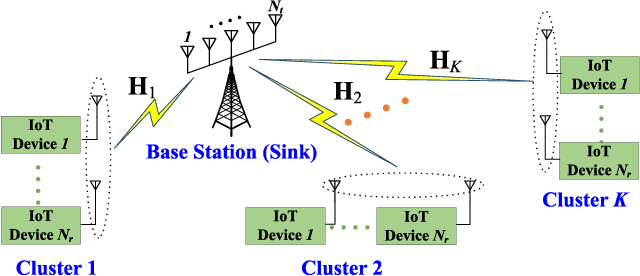


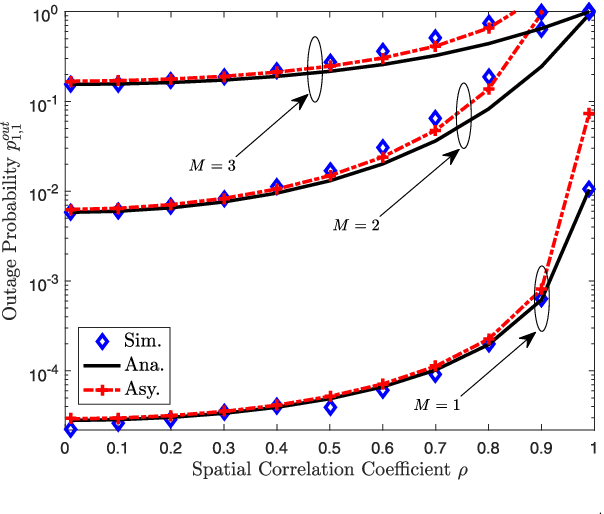
Abstract:To support massive connectivity and boost spectral efficiency for internet of things (IoT), a downlink scheme combining virtual multiple-input multiple-output (MIMO) and nonorthogonal multiple access (NOMA) is proposed. All the single-antenna IoT devices in each cluster cooperate with each other to establish a virtual MIMO entity, and multiple independent data streams are requested by each cluster. NOMA is employed to superimpose all the requested data streams, and each cluster leverages zero-forcing detection to de-multiplex the input data streams. Only statistical channel state information (CSI) is available at base station to avoid the waste of the energy and bandwidth on frequent CSI estimations. The outage probability and goodput of the virtual MIMO-NOMA system are thoroughly investigated by considering Kronecker model, which embraces both the transmit and receive correlations. Furthermore, the asymptotic results facilitate not only the exploration of physical insights but also the goodput maximization. In particular, the asymptotic outage expressions provide quantitative impacts of various system parameters and enable the investigation of diversity-multiplexing tradeoff (DMT). Moreover, power allocation coefficients and/or transmission rates can be properly chosen to achieve the maximal goodput. By favor of Karush-Kuhn-Tucker conditions, the goodput maximization problems can be solved in closed-form, with which the joint power and rate selection is realized by using alternately iterating optimization.Besides, the optimization algorithms tend to allocate more power to clusters under unfavorable channel conditions and support clusters with higher transmission rate under benign channel conditions.
Rate Splitting Multiple Access Aided Mobile Edge Computing in Cognitive Radio Networks
Apr 13, 2022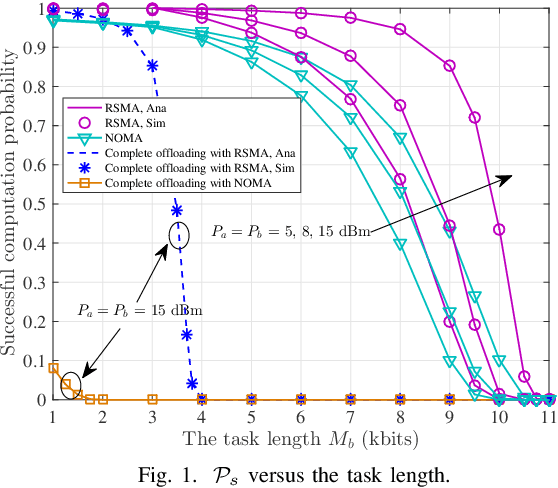
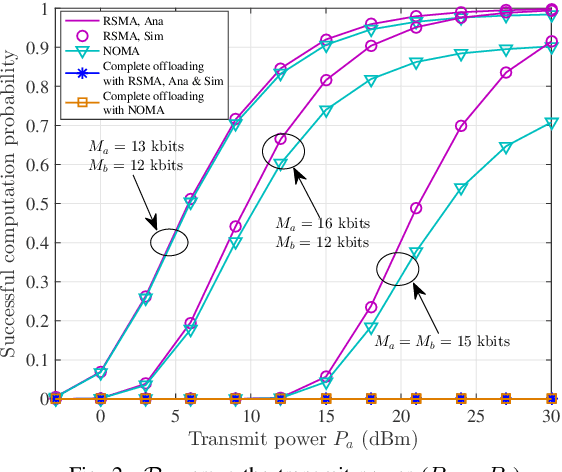
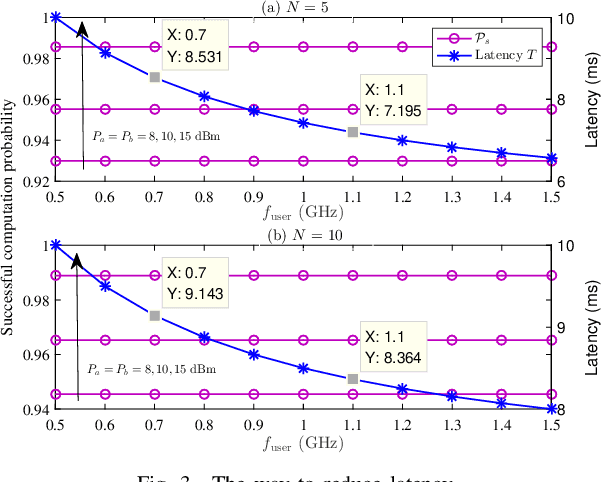
Abstract:In this paper, we investigate rate splitting multiple access (RSMA) aided mobile edge computing (MEC) in a cognitive radio network. We propose a RSMA scheme that enables the secondary user to offload tasks to the MEC server utilizing dynamic rate splitting without deteriorating the primary user's offloading. The expressions for the optimal rate splitting parameters that maximize the achievable rate for the secondary user and successful computation probability of the proposed RSMA scheme are derived in closed-form. We formulate a problem to maximize successful computation probability by jointly optimizing task offloading ratio and task offloading time and obtain the optimal solutions in closed-form. Simulation results clarify that the proposed RSMA scheme achieves a higher successful computation probability than the existing non-orthogonal multiple access scheme.
Non-Linear Age of Information: An Energy Efficient Receiver-Centric Approach
Dec 31, 2021



Abstract:The age of information (AoI) performance metric for point-to-point wireless communication systems is analytically studied under Rician-faded channels and when the receiver is equipped with multiple antennas. The general scenario of a non-linear AoI function is considered, which includes the conventional linear AoI as a special case. The stop-and-wait transmission policy is adopted, where the source node samples and then transmits new data only upon the successful reception of previous data. This approach can serve as a performance benchmark for any queuing system used in practice. New analytical and closed-form expressions are derived with respect to the average AoI and average peak AoI for the considered system configuration. We particularly focus on the energy efficiency of the said mode of operation, whereas some useful engineering insights are provided.
 Add to Chrome
Add to Chrome Add to Firefox
Add to Firefox Add to Edge
Add to Edge